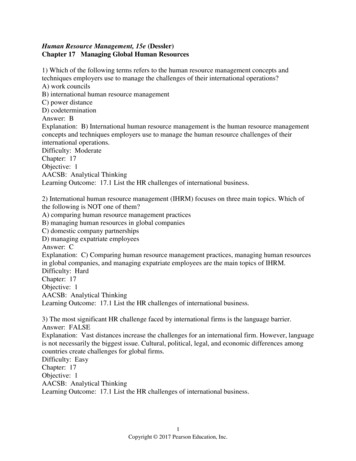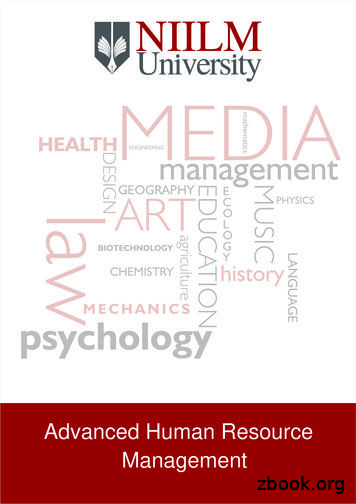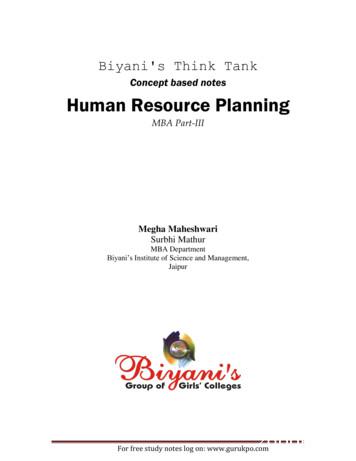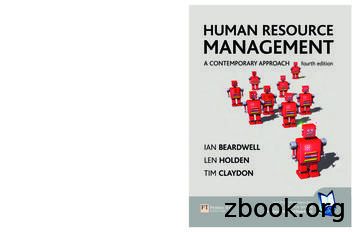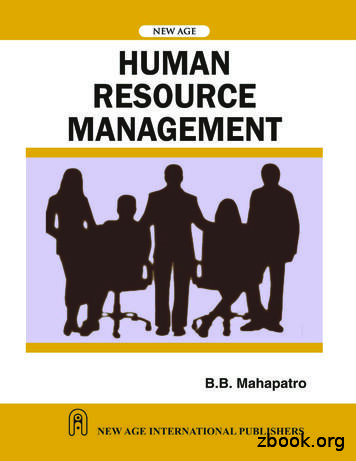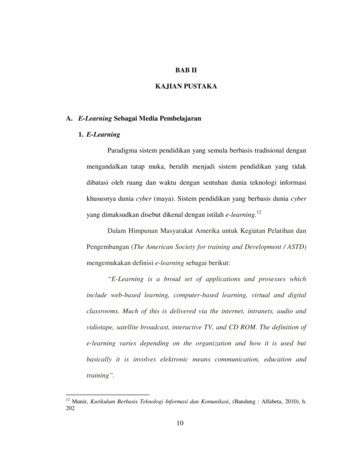Human Resource Management, 15e (Dessler) Chapter 17 .
Human Resource Management, 15e (Dessler)Chapter 17 Managing Global Human Resources1) Which of the following terms refers to the human resource management concepts andtechniques employers use to manage the challenges of their international operations?A) work councilsB) international human resource managementC) power distanceD) codeterminationAnswer: BExplanation: B) International human resource management is the human resource managementconcepts and techniques employers use to manage the human resource challenges of theirinternational operations.Difficulty: ModerateChapter: 17Objective: 1AACSB: Analytical ThinkingLearning Outcome: 17.1 List the HR challenges of international business.2) International human resource management (IHRM) focuses on three main topics. Which ofthe following is NOT one of them?A) comparing human resource management practicesB) managing human resources in global companiesC) domestic company partnershipsD) managing expatriate employeesAnswer: CExplanation: C) Comparing human resource management practices, managing human resourcesin global companies, and managing expatriate employees are the main topics of IHRM.Difficulty: HardChapter: 17Objective: 1AACSB: Analytical ThinkingLearning Outcome: 17.1 List the HR challenges of international business.3) The most significant HR challenge faced by international firms is the language barrier.Answer: FALSEExplanation: Vast distances increase the challenges for an international firm. However, languageis not necessarily the biggest issue. Cultural, political, legal, and economic differences amongcountries create challenges for global firms.Difficulty: EasyChapter: 17Objective: 1AACSB: Analytical ThinkingLearning Outcome: 17.1 List the HR challenges of international business.1Copyright 2017 Pearson Education, Inc.
4) International human resource management (IHRM) is the human resource managementconcepts and techniques employers use to manage the human resource challenges of theirinternational operations.Answer: TRUEExplanation: International human resource management (IHRM) is the human resourcemanagement concepts and techniques employers use to manage the human resource challengesof their international operations.Difficulty: EasyChapter: 17Objective: 1AACSB: Analytical ThinkingLearning Outcome: 17.1 List the HR challenges of international business.5) Geert Hofstede called the extent to which less powerful members of institutions accept andexpect an unequal power distribution .A) masculinityB) individualismC) power distanceD) tolerance for ambiguityAnswer: CExplanation: C) A study by Professor Geert Hofstede identified international culturaldifferences. For example, Hofstede says societies differ in power distance, which is the extent towhich the less powerful members of institutions accept and expect an unequal distribution ofpower.Difficulty: EasyChapter: 17Objective: 2AACSB: Analytical ThinkingLearning Outcome: 17.2 Illustrate with examples how intercountry differences affect HRM.6) According to research, which of the following is a greater concern to Chinese managers thanUnited States managers?A) getting tasks accomplished efficientlyB) keeping a distance from subordinatesC) enforcing a firm's policies and regulationsD) maintaining a harmonious work environmentAnswer: DExplanation: D) Although many managers endorse performance-based pay in China, otheremployers, to preserve group harmony, make incentive pay a small part of the pay package. And,as in other parts of Asia, team incentives are advisable.Difficulty: ModerateChapter: 17Objective: 2AACSB: Analytical ThinkingLearning Outcome: 17.2 Illustrate with examples how intercountry differences affect HRM.2Copyright 2017 Pearson Education, Inc.
7) In which country do individuals have a high acceptance of unequal power distributionbetween managers and subordinates?A) MexicoB) Hong KongC) SwedenD) United StatesAnswer: AExplanation: A) Power distance represents the extent to which the less powerful members ofinstitutions accept and expect an unequal distribution of power. Studies show that acceptance ofsuch inequality is higher in some countries (such as Mexico) than in others (such as Sweden).Mexican workers expect managers to keep their distance rather than to be close, and to be formalrather than informal.Difficulty: ModerateChapter: 17Objective: 2AACSB: Analytical ThinkingLearning Outcome: 17.2 Illustrate with examples how intercountry differences affect HRM.8) Of the countries listed below, in which one do production workers receive the lowest hourlywage?A) United StatesB) PhilippinesC) GermanyD) TaiwanAnswer: BExplanation: B) Hourly compensation costs (in U.S. dollars) for production workers range from 2.01 in the Philippines to 9.34 in Taiwan, 35.53 in the United States, 47.38 in Germany, to 64.15 in Norway.Difficulty: ModerateChapter: 17Objective: 2AACSB: Analytical ThinkingLearning Outcome: 17.2 Illustrate with examples how intercountry differences affect HRM.3Copyright 2017 Pearson Education, Inc.
9) are formal, employee-elected groups of worker representatives that meet monthlywith managers to discuss topics affecting the employees.A) Bargaining unitsB) Work councilsC) Mediation groupsD) Employee boardsAnswer: BExplanation: B) In many European countries, work councils replace the worker-managementmediations typical in U.S. firms. Work councils are formal, employee-elected groups of workerrepresentatives that meet monthly with managers to discuss topics ranging from no-smokingpolicies to layoffs.Difficulty: EasyChapter: 17Objective: 2AACSB: Analytical ThinkingLearning Outcome: 17.2 Illustrate with examples how intercountry differences affect HRM.10) In many European countries, replace the union-based worker-managementmediations typical in the U.S.A) HR managersB) corporate attorneysC) work councilsD) bargaining unitsAnswer: CExplanation: C) In many European countries, work councils replace the worker-managementmediations typical in U.S. firms. Work councils are formal, employee-elected groups of workerrepresentatives that meet monthly with managers to discuss topics ranging from no-smokingpolicies to layoffs.Difficulty: EasyChapter: 17Objective: 2AACSB: Analytical ThinkingLearning Outcome: 17.2 Illustrate with examples how intercountry differences affect HRM.4Copyright 2017 Pearson Education, Inc.
11) In Germany, employees have the legal right to a voice in setting company policies. This iscalled .A) codeterminationB) employment at willC) internal coordinationD) gainsharingAnswer: AExplanation: A) Codetermination is the rule in Germany and several other countries.Codetermination means employees have the legal right to a voice in setting company policies.Difficulty: EasyChapter: 17Objective: 2AACSB: Analytical ThinkingLearning Outcome: 17.2 Illustrate with examples how intercountry differences affect HRM.12) The European Union is best described as a .A) system of global standards, policies, and legislationB) common market for goods, services, capital, and laborC) political agreement that standardizes human resource lawsD) political system for equalizing wages, benefits, and taxationAnswer: BExplanation: B) The separate countries of the former European Community unified into acommon market for goods, services, capital, and even labor called the European Union (EU).Tariffs for goods moving across borders from one EU country to another generally disappeared,and employees now move freely between jobs in EU countries.Difficulty: ModerateChapter: 17Objective: 2AACSB: Analytical ThinkingLearning Outcome: 17.2 Illustrate with examples how intercountry differences affect HRM.13) Which of the following is a true statement regarding the European Union?A) EU employers must provide employees with written terms of their employment.B) EU employers must provide two weeks' notice when dismissing employees.C) Each EU country pays workers the same minimum hourly wage.D) Workers in the EU must live and work in their home country.Answer: AExplanation: A) The EU directive on confirmation of employment requires employers toprovide employees with written terms and conditions of their employment. Each countrydetermines the amount of notice to give employees, working hours, and wage rate. Workers maymove freely between jobs in EU countries.Difficulty: HardChapter: 17Objective: 2AACSB: Analytical ThinkingLearning Outcome: 17.2 Illustrate with examples how intercountry differences affect HRM.5Copyright 2017 Pearson Education, Inc.
14) Why is recruiting, hiring, and retaining good employees difficult in China?A) economic difficultiesB) unmotivated workersC) government restrictionsD) training requirementsAnswer: CExplanation: C) China's new labor contract law adds numerous new employment protections foremployees, and makes it correspondingly more expensive for employers in China to implementpersonnel actions such as layoffs.Difficulty: ModerateChapter: 17Objective: 2AACSB: Analytical ThinkingLearning Outcome: 17.2 Illustrate with examples how intercountry differences affect HRM.15) In China, qualified job candidates are most likely to be interested in a firm that offers.A) signing bonusesB) performance-based payC) job expansion opportunitiesD) training and development programsAnswer: DExplanation: D) Employees are highly career oriented and gravitate toward employers thatprovide the best career advancement training and opportunities. Group harmony is important inChina, so incentive pay is not advisable.Difficulty: ModerateChapter: 17Objective: 2AACSB: Analytical ThinkingLearning Outcome: 17.2 Illustrate with examples how intercountry differences affect HRM.16) Daniel is a manager for Siemens China, and it is time to conduct performance appraisals.During the appraisals, it would be most effective for Daniel to .A) link performance with employee bonusesB) make personal comments to the employeeC) focus on quantifiable, objective resultsD) post appraisal results for each teamAnswer: CExplanation: C) Employee appraisal is particularly sensitive to the cultural realities in China.The appraisal therefore needs to follow the formalities of saving face and avoidingconfrontational, tension-producing situations. In general, it's best to talk in terms of objectivework data (as opposed to personal comments like "you're too slow").Difficulty: HardChapter: 17Objective: 2AACSB: Application of KnowledgeLearning Outcome: 17.2 Illustrate with examples how intercountry differences affect HRM.6Copyright 2017 Pearson Education, Inc.
17) A major challenge for international businesses is the need to adapt personnel policies andprocedures to the differences among countries.Answer: TRUEExplanation: Taking the company global triggers various management challenges, includinghow to adapt personnel policies and procedures to various cultures and countries. Humanresource management must also consider its systems for recruiting, selecting, training, andappraising and compensating its workers abroad.Difficulty: EasyChapter: 17Objective: 2AACSB: Analytical ThinkingLearning Outcome: 17.2 Illustrate with examples how intercountry differences affect HRM.18) Codetermination means that employees have a legal right to voice opinions and preferencesin setting company policies.Answer: TRUEExplanation: Codetermination means employees have the legal right to a voice in settingcompany policies. Workers elect their own representatives to the supervisory board of theemployer.Difficulty: EasyChapter: 17Objective: 2AACSB: Analytical ThinkingLearning Outcome: 17.2 Illustrate with examples how intercountry differences affect HRM.19) Hourly wages for production workers in the United States are higher than those in Germany.Answer: FALSEExplanation: Differences in labor costs are substantial. For example, hourly compensation costsfor production workers range from 2.01 in the Philippines, to 9.34 in Taiwan, 35.53 in theUnited States, 47.38 in Germany, to 64.15 in Norway.Difficulty: EasyChapter: 17Objective: 2AACSB: Analytical ThinkingLearning Outcome: 17.2 Illustrate with examples how intercountry differences affect HRM.20) The official length of a work week in the European Union is 40 hours.Answer: FALSEExplanation: The EU sets the workweek at 48 hours, but most EU countries set it at 40 hours aweek.Difficulty: EasyChapter: 17Objective: 2AACSB: Analytical ThinkingLearning Outcome: 17.2 Illustrate with examples how intercountry differences affect HRM.7Copyright 2017 Pearson Education, Inc.
21) In China, a structured interview process is the typical method for selecting employees.Answer: TRUEExplanation: The dominant employee selection method in China involves analyzing theapplicant's résumé and then interviewing him or her. The ideal way to do this is to institute astructured interview process, as many of the foreign firms in China have done.Difficulty: EasyChapter: 17Objective: 2AACSB: Analytical ThinkingLearning Outcome: 17.2 Illustrate with examples how intercountry differences affect HRM.22) In a planned economy, such as China, some industries are under the direct control of thegovernment while other industries are free to make pricing and production decisions based onmarket demand.Answer: FALSEExplanation: In planned economies (such as North Korea), the government decides and planswhat to produce and sell, at what price. In mixed economies (such as China), many industries arestill under direct government control, while others make pricing and production decisions basedon market demand.Difficulty: ModerateChapter: 17Objective: 2AACSB: Analytical ThinkingLearning Outcome: 17.2 Illustrate with examples how intercountry differences affect HRM.23) In a brief essay, discuss the economic and labor relations factors that are unique to Europe.Answer: Differences in economic systems also translate into differences in human resourcemanagement policies. For instance, some countries in the Euro zone tend to put more restrictionson the number of hours an employee can legally work each week. Differences in labor costs arealso substantial. Hourly compensation costs for production workers vary as well. SeveralEuropean countries, including the United Kingdom and Germany, require substantial severancepay to departing employees. The U.S. practice of employment at will does not exist in Europe,where firing or laying off workers is usually expensive. And in many European countries, workcouncils replace the worker-management mediations typical in U.S. firms. Codetermination isthe rule in Germany and several other countries. Unions in Europe are influential, and labormanagement bargaining and relations reflect this fact. In general, four issues characterizeEuropean labor relations: centralization, employer organization, union recognition, and contentand scope of bargaining.Difficulty: HardChapter: 17Objective: 2AACSB: Analytical ThinkingLearning Outcome: 17.2 Illustrate with examples how intercountry differences affect HRM.8Copyright 2017 Pearson Education, Inc.
24) are citizens of the countries where they are working.A) Home-country nationalsB) Multi-nationalsC) ExpatriatesD) LocalsAnswer: DExplanation: D) Locals are citizens of the countries where they are working. Expatriates arenon-citizens of the countries in which they are working. Home-country nationals are citizens ofthe country in which the multinational company has its headquarters.Difficulty: EasyChapter: 17Objective: 3AACSB: Analytical ThinkingLearning Outcome: 17.3 List and briefly describe the main methods for staffing globalorganizations.25) Of the types of international workers that multinational companies can employ, locals arebest described as .A) citizens of the countries where they are workingB) noncitizens of the countries in which they are workingC) citizens of the country in which the multinational company has its headquartersD) noncitizens of the country in which the multinational company has its headquartersAnswer: AExplanation: A) Locals are citizens of the countries where they are working. Expatriates arenon-citizens of the countries in which they are working. Home-country nationals are citizens ofthe country in which the multinational company has its headquarters.Difficulty: EasyChapter: 17Objective: 3AACSB: Analytical ThinkingLearning Outcome: 17.3 List and briefly describe the main methods for staffing globalorganizations.9Copyright 2017 Pearson Education, Inc.
26) Marie is an Italian executive working in a manufacturing plant in Siena, Italy that is ownedby a parent company based in Singapore. Marie is a(n) .A) localB) expatriateC) third-country nationalD) home-country nationalAnswer: AExplanation: A) Locals are citizens of the countries where they are working. Expatriates arenon-citizens of the countries in which they are working. Home-country nationals are citizens ofthe country in which the multinational company has its headquarters.Difficulty: ModerateChapter: 17Objective: 3AACSB: Application of KnowledgeLearning Outcome: 17.3 List and briefly describe the main methods for staffing globalorganizations.27) Jason is a British freelance journalist working in Paris, so he is most likely classified as a(n).A) localB) expatriateC) third-country nationalD) home-country nationalAnswer: BExplanation: B) Expatriates are non-citizens of the countries in which they are working. Localsare citizens of the countries where they are working. Home-country nationals are citizens of thecountry in which the multinational company has its headquarters. Third-country nationals arecitizens of a country other than the parent or the host country.Difficulty: ModerateChapter: 17Objective: 3AACSB: Application of KnowledgeLearning Outcome: 17.3 List and briefly describe the main methods for staffing globalorganizations.10Copyright 2017 Pearson Education, Inc.
28) are noncitizens of the countries in which they are working.A) Home-country nationalsB) Third-country nationalsC) ExpatriatesD) LocalsAnswer: CExplanation: C) Expatriates are non-citizens of the countries in which they are working. Localsare citizens of the countries where they are working. Home-country nationals are citizens of thecountry in which the multinational company has its headquarters.Difficulty: EasyChapter: 17Objective: 3AACSB: Analytical ThinkingLearning Outcome: 17.3 List and briefly describe the main methods for staffing globalorganizations.29) In January 2009, Walmart acquired a controlling interest in Chile's leading food retailer.Since then, Walmart has opened the first environmentally friendly supermarket in Chile that usesenergy efficient technology throughout the store. Walmart is planning to open additional storesin Chile over the next seven years. Walmart's top executives are considering the idea oftransferring U.S. managers to Chile to oversee the construction and establishment of the newstores.Which of the following questions is LEAST relevant to the decision to fill management positionsin Chile with expatriates?A) What will be the relocation and compensation costs to Walmart of using expatriates?B) What level of corporate control is needed for opening the new Walmart stores?C) What is the planned Walmart marketing strategy for the new stores in Chile?D) What is the typical attrition rate for expatriate employees at Walmart?Answer: CExplanation: C) Marketing strategy is irrelevant to a staffing decision. Costs, corporate control,and attrition rates are important aspects to consider when debating between filling managementpositions with locals or expatriates.Difficulty: HardChapter: 17Objective: 3AACSB: Application of KnowledgeLearning Outcome: 17.3 List and briefly describe the main methods for staffing globalorganizations.11Copyright 2017 Pearson Education, Inc.
30) Which of the following terms refers to citizens of a country other than the parent or the hostcountry?A) third-country nationalB) home-country nationalC) multi-nationalD) localAnswer: AExplanation: A) Third-country nationals are citizens of a country other than the parent or thehost country. Home-country nationals are citizens of the country in which the multinationalcompany has its headquarters.Difficulty: EasyChapter: 17Objective: 3AACSB: Analytical ThinkingLearning Outcome: 17.3 List and briefly describe the main methods for staffing globalorganizations.31) Peter is a German citizen working as a manager for Siemens in Freiberg, Germany. Siemenshas facilities all over the world but its headquarters is in Germany. Peter is best categorized asa(n) .A) expatriateB) third-country nationalC) home-country nationalD) host-country nationalAnswer: CExplanation: C) Home-country nationals are citizens of the country in which the multinationalcompany has its headquarters.Difficulty: ModerateChapter: 17Objective: 3AACSB: Application of KnowledgeLearning Outcome: 17.3 List and briefly describe the main methods for staffing globalorganizations.12Copyright 2017 Pearson Education, Inc.
32) Which of the following terms refers to citizens of the country in which the multinationalcompany has its headquarters?A) expatriatesB) third-country nationalsC) home-country nationalsD) localsAnswer: CExplanation: C) Home-country nationals are citizens of the country in which the multinationalcompany has its headquarters.Difficulty: EasyChapter: 17Objective: 3AACSB: Analytical ThinkingLearning Outcome: 17.3 List and briefly describe the main methods for staffing globalorganizations.33) Roberta is an Italian citizen who spent a great deal of time during her childhood in England.She now works in Brazil as an HR manager for a British company. Roberta is best described asa(n) .A) expatriateB) third-country nationalC) home-country nationalD) host-country nationalAnswer: BExplanation: B) Third-country nationals are citizens of a country other than the parent or thehost country.Difficulty: ModerateChapter: 17Objective: 3AACSB: Application of KnowledgeLearning Outcome: 17.3 List and briefly describe the main methods for staffing globalorganizations.13Copyright 2017 Pearson Education, Inc.
34) In January 2009, Walmart acquired a controlling interest in Chile's leading food retailer.Since then, Walmart has opened the first environmentally friendly supermarket in Chile that usesenergy efficient technology throughout the store. Walmart is planning to open additional storesin Chile over the next seven years. Walmart's top executives are considering the idea oftransferring U.S. managers to Chile to oversee the construction and establishment of the newstores.Which of the following, if true, supports the argument that locals should be hired to fillmanagement positions in Chile?A) Chile has a high percentage of younger workers with college degrees.B) Managers in Chile are expected to keep their distance from subordinates.C) Chile has had an increase in foreign direct investment over the last five years.D) Chileans expect managers and subordinates to interact in a highly informal manner.Answer: AExplanation: A) A high number of skilled and educated locals suggests that Walmart would beable to find competent managers in Chile. The interaction between managers and subordinatesdoes not necessarily explain why locals should be hired as managers instead of expatriates.Difficulty: HardChapter: 17Objective: 3AACSB: Application of KnowledgeLearning Outcome: 17.3 List and briefly describe the main methods for staffing globalorganizations.35) Which of the following is the primary disadvantage of using expatriates to fill foreignsubsidiary management positions?A) high costs associated with relocationB) time and effort required for trainingC) inability to create short-term resultsD) security concernsAnswer: AExplanation: A) The cost of posting someone abroad is very high due to travel, relocation,housing, and salary.Difficulty: ModerateChapter: 17Objective: 3AACSB: Analytical ThinkingLearning Outcome: 17.3 List and briefly describe the main methods for staffing globalorganizations.14Copyright 2017 Pearson Education, Inc.
36) All of the following are reasons that firms rely heavily on locals to fill foreign subsidiarymanagement positions EXCEPT .A) pressure from local governmentB) lower costs than using expatriatesC) improved public relations in communityD) high level of skills and technical qualificationsAnswer: DExplanation: D) The cost of using expatriates is a key reason that firms use locals. Localgovernments often pressure firms to use locals, and doing so improves the firm's PR in thecommunity. The drawback of locals is that they likely do not have the necessary technicalqualifications and require extensive training.Difficulty: HardChapter: 17Objective: 3AACSB: Analytical ThinkingLearning Outcome: 17.3 List and briefly describe the main methods for staffing globalorganizations.37) In January 2009, Walmart acquired a controlling interest in Chile's leading food retailer.Since then, Walmart has opened the first environmentally friendly supermarket in Chile that usesenergy efficient technology throughout the store. Walmart is planning to open additional storesin Chile over the next seven years. Walmart's top executives are considering the idea oftransferring U.S. managers to Chile to oversee the construction and establishment of the newstores.Which of the following, if true, best supports the argument of using expatriates to establish thenew Walmart stores in Chile?A) Local candidates with the necessary managerial experience are difficult to find in Chile.B) Walmart uses an online recruiting system to facilitate human resources activities.C) The State Department has issued travel alerts for Americans traveling in Chile.D) Walmart wants to develop good relationships with the local community.Answer: AExplanation: A) The primary reason to use expatriates instead of locals is when qualified localcandidates cannot be found. Hiring locals instead of expatriates would most likely help improvecommunity relations.Difficulty: HardChapter: 17Objective: 3AACSB: Application of KnowledgeLearning Outcome: 17.3 List and briefly describe the main methods for staffing globalorganizations.15Copyright 2017 Pearson Education, Inc.
38) Sara, who is originally from India, works in Texas for Dell as an IT manager. Dell, whichhas a localization policy, recently announced that management positions are available in itsBangalore, India facility. If Sara, who wants to return to India, is offered the Bangalore position,she would most likely be categorized as a(n) .A) commuter employeeB) independent contractorC) third-country nationalD) permanent transfereeAnswer: DExplanation: D) About 78% of employers have some form of "localization" policy. This is apolicy of transferring a home-country national employee to a foreign subsidiary as a "permanenttransferee." In this case, Sara is a U.S. Dell employee originally from India. If she moves backshe would be a permanent transferee.Difficulty: ModerateChapter: 17Objective: 3AACSB: Application of KnowledgeLearning Outcome: 17.3 List and briefly describe the main methods for staffing globalorganizations.39) Which of the following terms refers to having local employees abroad do jobs that the firm'sdomestic employees previously did in-house?A) adaptingB) offshoringC) enlargingD) diversifyingAnswer: BExplanation: B) Offshoring means having local employees abroad do jobs that the firm'sdomestic employees previously did in-house. Offshoring is an increasingly popular staffingoption.Difficulty: EasyChapter: 17Objective: 3AACSB: Analytical ThinkingLearning Outcome: 17.3 List and briefly describe the main methods for staffing globalorganizations.16Copyright 2017 Pearson Education, Inc.
40) Call centers that service customers for firms like software and computer hardware companiesare increasingly using employees in India to staff the telephones. This is an example of.A) outsourcingB) offshoringC) downsizingD) international staffingAnswer: BExplanation: B) Offshoring means having local employees abroad do jobs that the firm'sdomestic employees previously did in-house. Offshoring is a popular staffing option, especiallyfor call centers.Difficulty: ModerateChapter: 17Objective: 3AACSB: Application of KnowledgeLearning Outcome: 17.3 List and briefly describe the main methods for staffing globalorganizations.41) Which of the following corporate divisions plays the greatest role in offshoring?A) marketingB) accountingC) manufacturingD) human resourcesAnswer: DExplanation: D) When developing foreign markets or opening new manufacturing facilities,marketing, sales, and production executives play the pivotal roles. Offshoring mostly involvesHR management as firms seek to gain cost advantages. Firms look to their HR managers to helpidentify high-quality, low-cost talent abroad, and to provide the necessary information on skills,foreign wage rates, and working conditions.Difficulty: ModerateChapter: 17Objective: 3AACSB: Analytical ThinkingLearning Outcome: 17.3 List and briefly describe the main methods for staffing globalorganizations.17Copyright 2017 Pearson Education, Inc.
42) Which of the following terms refers to the belief that home country attitudes, managementstyle, knowledge, evaluation criteria, and managers are superior to anything the host country hasto offer?A) polycentricB) ethnocentricC) geocentricD) monocentricAnswer: BExplanation: B) An ethnocentric corporation believes that home-country attitudes, managementstyle, knowledge, evaluation criteria, and managers are superior to anything the host countrymight have to offer.Difficulty: EasyChapter: 17Objective: 3AACSB: Analytical ThinkingLearning Outcome: 17.3 List and briefly describe the main methods for staffing globalorganizations.43) A corporation that believes that only host country managers can ever really understand theculture and behavior of the host countr
B) international human resource management C) power distance D) codetermination Answer: B Explanation: B) International human resource management is the human resource management concepts and techniques employers use to manage the human resource challenges of their international
Human Resource Management, 15e (Dessler) Chapter 4 Job Analysis and the Talent Management Process 1) Which term refers to the holistic, integrated and results and goal-oriented process of planning, recruiting, selecting, developing, managing, and compensating employees? A) job analysis B) HR alignment C) strategic planning D) talent management
Human Resource Management, 15e (Dessler) Chapter 16 Safety, Health, and Risk Management 1) While accident rates are falling, in one recent year _ U.S. workers died in workplace incidents. A) 2369 B) 4405 C) 6278 D) 8100 Answer: B Explanation: B) In one recent year, 4,405 U.S. workers died in workplace events, and workplace
Human Resource Management, 15e (Dessler) Chapter 6 Employee Testing and Selection . techniques, not the results of the new tests. After they have been on the job for some time, measure their performance and compar
Human Resource Management, 15e (Dessler) Chapter 10 Employee Retention, Engagement, and Careers . Explanation: A) Career planning is the deliberate process through which someone becomes aware of his or her personal skills, interests, knowledge, motivations, and other characteristics.
Human Resource Management, 15e (Dessler) Chapter 7 Interviewing Candidates 1) Which of the following is the most commonly used selection tool? A) telephone reference B) reference letter C) interview D) personality test Answer: C Explanation: C) Interviews are the most widely used selection procedure. Not all managers useFile Size: 261KBPage Count: 45
Gary Dessler Chapter 7 Part 2 Recruitment and Placement Interviewing Candidates. After studying this chapter, you should be able to: 1. List the main types of selection interviews. 2. . Human Resource Management 10e.- Gary Dessler Author: Charlie Cook, The University of West Alabama
Gary Dessler Chapter 5 Part 2 Recruitment and Placement . Human Resource Information System (HRIS) -Computerized inventory of information that can be accessed to determine employees' background, . -Applying best-practices management techniques to recruiting.
AACSB: Analytical Thinking Learning Outcome: 9.1 Describe the performance appraisal process. 5) All of the following are reasons for appraising an employee's performance EXCEPT _. A) correcting any work-related deficiencies B) creating an organizational strategy
AACSB: Analytical Thinking Learning Outcome: 11.1 List the basic factors determining pay rates. 6) Which of the following was enacted in 1931
Explanation: C) Strategic goals (perhaps to enter new lines of business or to expand abroad) often mean the firm will have to fill new jobs. Strategic training needs analysis identifies the training employees will need to fill these future jobs. Difficulty: Moderate Chapter:
Human Resource Management Human Resource Policy QUADRANT-I Module 4: Human Resource Policy 1. Learning Outcome 2. Definition 3. Employee understanding on HR Policy 4. Benefits of policy 5. Specific Personal policies 6. Responsibility for policy making 7. Formulation of Human Resource Policy 8. Principles 9. Procedures 10. Programs 11. Summary 1.
In this text we will focus on one of these functions the stafng, personnel management, or hu-man resource management (HRM ) function. Human resource management is the process of acquiring, training, appraising, and compensating employees, and of attending to their labor rela-tions, health and safety, and fairness concerns.
Human Resource Management Question Answer Bank MBA-203 Q.1 What is Human Resource Management Human Resource Management is a process, which consists of four main activities, namely, acquisition, development, motivation, as well as maintenance of human resources. Scott, Clothier and Spriegel have defined Human Resource Management as that
1.1.2 Evolution of Human Resource Management 1.1.3 Human Resource Management: Nature 1.1.4 Human Resource Management: Scope 1.1.5 Human Resource Management: Objectives 1.2 Functions of HRM 1.3 Growing Importance of HRM Functions 1.3.1 Factors Contributing to the Growing Importance of HRM 1.4 Concepts and Essential of Management
Ans Human resource planning can be defined as the process of identifying the number of people required by an organization in terms of quantity and quality. All human resource management activities start with human resource planning. So we can say that human resource planning is the principle/primary activity of human resource management.
human resource functions while keeping them satisfied in their work. It covers a wide range of chapters on human resource management such as human resource functions, performance management and human resource development and empowerment. This module serves the purpose of a resource handbook for carrying out training on Human Resource Management
Human resource management: the state of the debate 24 Summary 27 Activity 28 References and further reading 29 2 Strategic human resource management Nicky Golding 32 Objectives 32 Introduction to strategic human resource management 32 Understanding the business context 34 Approaches to the strategy-making pr
1.3 Definition of Human Resources Management 3 1.4 A New Mandate for Human Resources 4 1.5 Changing Role of the Human Resource Management 5 1.6 Managing human resources in the emerging scenario 7 1.7 Evolution of Management of Human Resources: An Indian Perspective 10 References 16 2. THE CONCEPT, SCOPE AND FUNCTION OF HUMAN RESOURCE OF .
Fundamentals of Human Resource Management MB —I Gary Dessler Florida International University PEARSON Boston Columbus Indianapolis New York San Francisco Amsterdam CapeTown Dubai London Madrid Milan Munich Paris Montreal Toronto Delhi Mexico City Sä
Asam folat dapat diperoleh dari daging, sayuran berwarna hijau, dan susu. Gizi buruk (malnutrisi) merupakan penyebab utamanya. Anemia jenis ini jugaberkaitan dengan pengerutan hati (sirosis). Sirosis hati menyebabkan cadangan asam folat di dalamnya menjadi sedikit sekali. Kekurangan asam folat juga dapat menyebabkan gangguan kepribadian dan hilangnya daya ingat. Gejala-gejalanya hampir sama .
